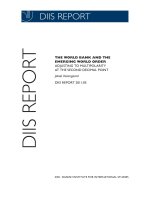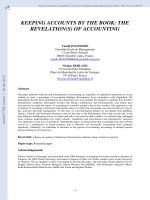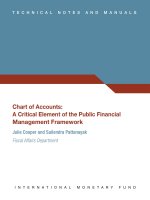Adjusting the accounts
Bạn đang xem bản rút gọn của tài liệu. Xem và tải ngay bản đầy đủ của tài liệu tại đây (3.26 MB, 78 trang )
3-1
3
Adjusting the Accounts
Learning Objectives
After studying this chapter, you should be able to:
[1] Explain the time period assumption.
[2] Explain the accrual basis of accounting.
[3] Explain the reasons for adjusting entries and Identify the major types of
adjusting entries.
[4] Prepare adjusting entries for deferrals.
[5] Prepare adjusting entries for accruals.
[6] Describe the nature and purpose of an adjusted trial balance.
3-2
Preview of Chapter 3
Accounting Principles
Eleventh Edition
Weygandt Kimmel Kieso
3-3
Timing Issues
Accountants divide the economic life of a business into
artificial time periods (Time Period Assumption).
.....
Jan.
Feb.
Generally a
3-4
month,
quarter, or
year.
Mar.
Apr.
Dec.
Alternative Terminology
The time period assumption
is also called the
periodicity assumption.
LO 1 Explain the time period assumption.
Timing Issues
Fiscal and Calendar Years
3-5
Monthly and quarterly time periods are called interim
periods.
Public companies must prepare both quarterly and annual
financial statements.
Fiscal Year = Accounting time period that is one year in
length.
Calendar Year = January 1 to December 31.
LO 1 Explain the time period assumption.
Timing Issues
Review Question
The time period assumption states that:
a. revenue should be recognized in the accounting
period in which it is earned.
b. expenses should be matched with revenues.
c. the economic life of a business can be divided into
artificial time periods.
d. the fiscal year should correspond with the calendar
year.
3-6
LO 1 Explain the time period assumption.
Timing Issues
Accrual- versus Cash-Basis Accounting
Accrual-Basis Accounting
3-7
Transactions recorded in the periods in which the
events occur.
Companies recognize revenues when they perform
services (rather than when cash is received).
Expenses are recognized when incurred (rather than
when paid).
LO 2 Explain the accrual basis of accounting.
Timing Issues
Accrual- vs. Cash-Basis Accounting
Cash-Basis Accounting
3-8
Revenues recognized when cash is received.
Expenses recognized when cash is paid.
Cash-basis accounting is not in accordance with
generally accepted accounting principles (GAAP).
LO 2 Explain the accrual basis of accounting.
Timing Issues
Recognizing Revenues and Expenses
REVENUE RECOGNITION PRINCIPLE
Recognize revenue in the
accounting period in which the
performance obligation is
satisfied.
3-9
LO 2
Timing Issues
Recognizing Revenues and Expenses
EXPENSE RECOGNITION PRINCIPLE
Match expenses with
revenues in the period when
the expense makes its
contribution to revenue.
“Let the expenses follow
the revenues.”
3-10
LO 2
Timing Issues
Illustration 3-1
GAAP relationships in revenue
and expense recognition
3-11
LO 2
Timing Issues
Review Question
One of the following statements about the accrual basis of
accounting is false? That statement is:
a. Events that change a company’s financial statements are
recorded in the periods in which the events occur.
b. Revenue is recognized in the period in which the
performance obligation is satisfied.
c. The accrual basis of accounting is in accord with generally
accepted accounting principles.
d. Revenue is recorded only when cash is received, and
expenses are recorded only when cash is paid.
3-12
LO 2 Explain the accrual basis of accounting.
3-13
LO 2 Explain the accrual basis of accounting.
>
DO
DO IT!
IT!
A list of concepts is provided in the left column below, with a description of the
concept in the right column below. There are more descriptions provided than
concepts. Match the description of the concept to the concept.
f Accrual-basis accounting.
1. ___
(a) Monthly and quarterly time periods.
e Calendar year.
2. ___
(b) Efforts (expenses) should be matched
with results (revenues).
c Time period assumption.
3. ___
b Expense recognition
4. ___
principle.
(c) Accountants divide the economic life of
a business into artificial time periods.
(d) Companies record revenues when they
receive cash and record expenses
when they pay out cash.
(e) An accounting time period that starts on
January 1 and ends on December 31.
(f)
3-14
Companies record transactions in the
period in which the events occur.
LO 2
The Basics of Adjusting Entries
Adjusting Entries
3-15
Ensure that the revenue recognition and expense
recognition principles are followed.
Necessary because the trial balance may not contain
up-to-date and complete data.
Required every time a company prepares financial
statements.
Will include one income statement account and one
balance sheet account.
LO 3 Explain the reasons for adjusting entries and
Identify the major types of adjusting entries.
The Basics of Adjusting Entries
Review Question
Adjusting entries are made to ensure that:
a. expenses are recognized in the period in which
they are incurred.
b. revenues are recorded in the period in which
services are performed.
c. balance sheet and income statement accounts
have correct balances at the end of an accounting
period.
d. all of the above.
3-16
LO 3 Explain the reasons for adjusting entries and
Identify the major types of adjusting entries.
The Basics of Adjusting Entries
Types of Adjusting Entries
Deferrals
Accruals
1. Prepaid Expenses.
1. Accrued Revenues.
Expenses paid in cash before
they are used or consumed.
2. Unearned Revenues.
Revenues for services
performed but not yet received
in cash or recorded.
2. Accrued Expenses.
Cash received before services
are performed.
3-17
Illustration 3-2
Categories of adjusting entries
Expenses incurred but not yet
paid in cash or recorded.
LO 3 Explain the reasons for adjusting entries and
Identify the major types of adjusting entries.
The Basics of Adjusting Entries
Types of Adjusting Entries
Trial Balance –
Each account is
analyzed to
determine whether
it is complete and
up-to-date.
Illustration 3-3
3-18
LO 3 Explain the reasons for adjusting entries and
Identify the major types of adjusting entries.
The Basics of Adjusting Entries
Adjusting Entries for Deferrals
Deferrals are expenses or revenues that are
recognized at a date later than the point when cash
was originally exchanged. There are two types:
3-19
Prepaid expenses and
Unearned revenues.
LO 4 Prepare adjusting entries for deferrals.
The Basics of Adjusting Entries
PREPAID EXPENSES
Payment of cash, that is recorded as an asset because
service or benefit will be received in the future.
Cash Payment
BEFORE
Expense Recorded
Prepayments often occur in regard to:
3-20
insurance
rent
supplies
equipment
advertising
buildings
LO 4 Prepare adjusting entries for deferrals.
The Basics of Adjusting Entries
PREPAID EXPENSES
Expire either with the passage of time or through use.
Adjusting entry:
►
Increase (debit) to an expense account and
►
Decrease (credit) to an asset account.
Illustration 3-4
3-21
LO 4 Prepare adjusting entries for deferrals.
The Basics of Adjusting Entries
Illustration: Pioneer Advertising Agency
purchased supplies costing $2,500 on
October 5. Pioneer recorded the payment
by increasing (debiting) the asset
Supplies. This account shows a balance
of $2,500 in the October 31 trial balance.
An inventory count at the close of
business on October 31 reveals that
$1,000 of supplies are still on hand.
Oct. 31
Supplies expense
Supplies
3-22
1,500
1,500
LO 4 Prepare adjusting entries for deferrals.
The Basics of Adjusting Entries
Illustration 3-5
3-23
LO 4
The Basics of Adjusting Entries
Illustration: On October 4, Pioneer
Advertising Agency paid $600 for a one-year
fire insurance policy. Coverage began on
October 1. Pioneer recorded the payment by
increasing (debiting) Prepaid Insurance. This
account shows a balance of $600 in the
October 31 trial balance. Insurance of $50
($600 ÷ 12) expires each month.
Oct. 31
Insurance expense
50
Prepaid insurance
3-24
50
LO 4 Prepare adjusting entries for deferrals.
The Basics of Adjusting Entries
Illustration 3-6
3-25
LO 4









